MiGs, Stars & Magic Books: A Brief History of Trespassing in Moscow
An illustrated guide to urban exploration in the Russian capital.

2 February 2017
It was sometime around midnight, and we stood on the cracked plaza of the Kyiv Crematorium flashing spotlights up and down the building’s flaking, crusted flanks. It looked more grown, than built; there was nothing macabre about this temple of the dead, this literal terminus, but rather it bubbled and clawed out of the ground in a series of indecipherable gestures. The architecture of an alternate dimension.
Even with my tripod, my multiple lenses, shutter remote and a selection of torches, I had finished documenting the building in 30 minutes and then packed up my toolbox for the night. But I wasn’t alone. I was exploring with Beijing-based photo-sorceress Xiao Yang and she was still working an hour later – an extraordinary process to watch. She chain-smoked her way through a pack of cigarettes while setting the crematorium alight with sun-bright beams… and lashing it with a fibre-optic whip that looked like some kind of sci-fi duelling weapon.
Sometimes, she had me pose in her pictures to create black silhouettes – a human form, for scale – but the rest of the time, I floated about the plaza and gazed out over the midnight cemetery. Stones and crosses rose from the falling hillside, barely discernible in the dark; beyond that the lights of the city, Kyiv’s palatial post-modernist towers, blazed as distant beacons outside the necropolis.

Across the empty spaces, dogs howled at one another. Then I heard a human voice: a shout, far off, from the other end of the cemetery.
“I think someone is coming,” I told Xiao. It was hardly surprising – Kyiv’s ‘Park of Memory’ is closed at night, off-limits to the public. For the last several hours we’d been creating vivid light displays across the bone-white monument at its heart. Security were bound to notice sooner or later.
Out of the darkness, two men in military-style uniforms marched suddenly onto the plaza. They wore camouflage fatigues and big boots, with batons dangling from their belts. One of them barked an order which neither Xiao nor myself understood; but the meaning, of course, was quite clear: it was time to leave.
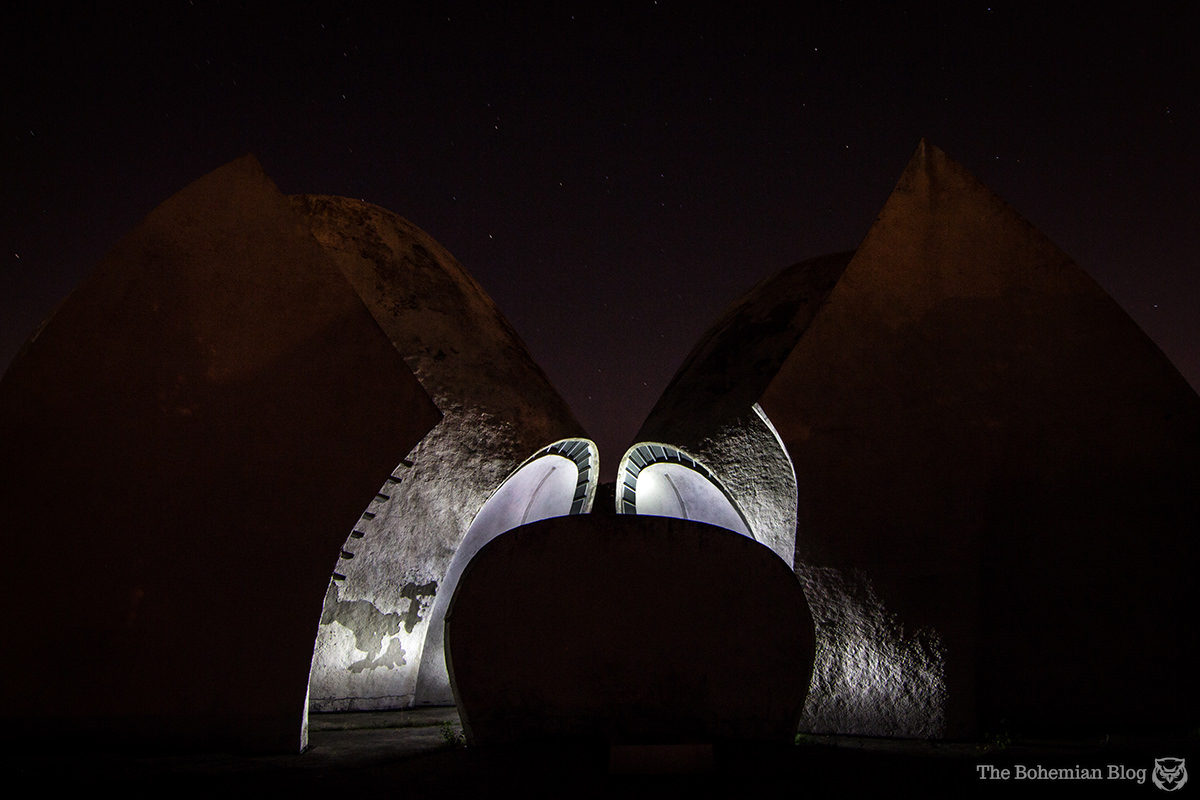
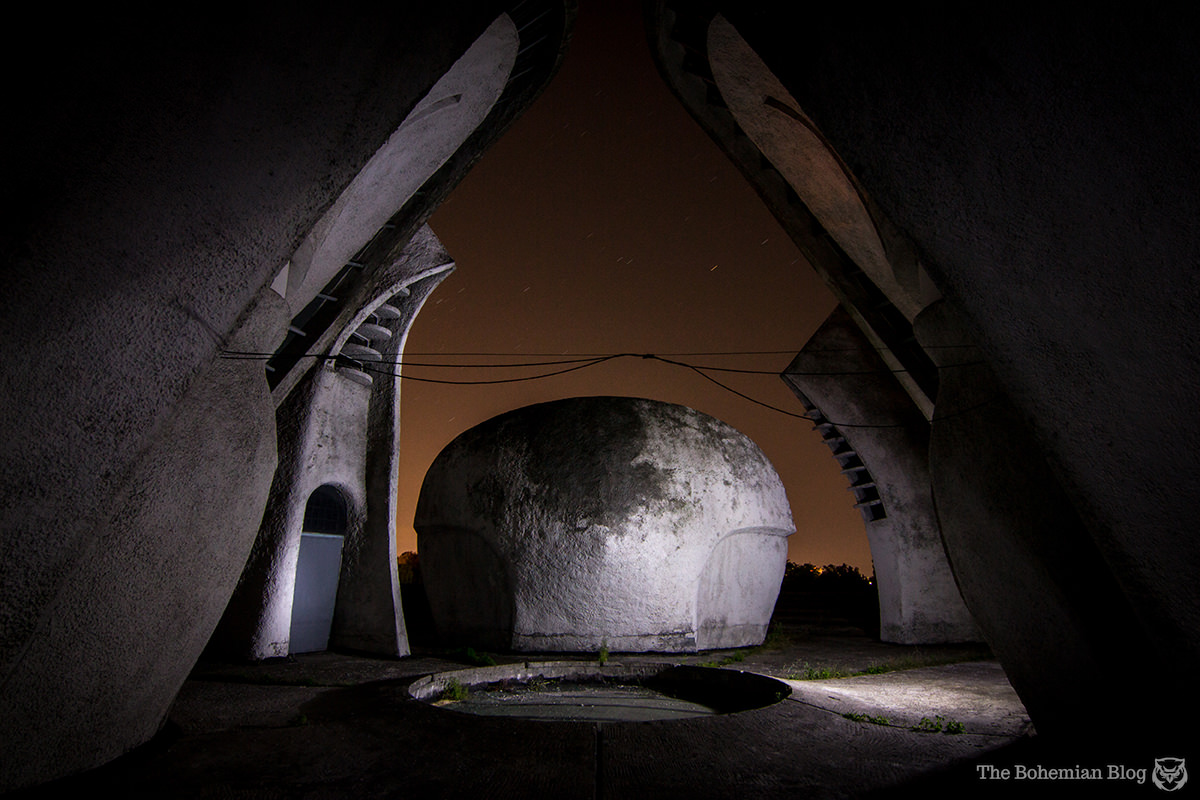
I was visiting Kyiv that week to co-lead my first Ukrainian tour, but I had also allowed the time for some fresh adventures. My old friend General Kosmosa, a local urban explorer, was out of town – but his fellow digger Maxim was more than willing to show us around.
Disaster struck first, though – that night after the crematorium, I managed to get locked out of my apartment. I lost my keys, my SIM card and my dignity (that’s a long story in itself, but you can read it here)… so that by 12 the following day, when the three of us met for a 48-hour tour around and underneath the Ukrainian capital, I already felt dead on my feet. I dosed up on coffee; slammed a can of energy drink as I dragged myself to the rendezvous.
Before long, and certainly by the time we descended into the maze of ladders and dripping pipes beneath Kyiv, I knew the adrenaline would kick in – but I could only hope it’d last me through to the end of our two-day expedition.
Kyiv was built on hills. The Upper City area – ‘Old Kyiv’ – rises as a glittering citadel over the Lower City, ‘Podil’; and beneath those hills, the land tumbles down to the banks of the River Dnieper. When it rains, the water streams down the flanks of Old Kyiv – it forms rushing torrents the length of Andriivsky Descent – and the subsoil here, as a result, was historically prone to landslides and erosion.
For that reason, the ongoing survival of Old Kyiv owes much to an ingenious system of subterranean drainage.

The military engineer and Imperial Russian general Eduard Totleben (1818-1884) is often credited as the brains behind the drains; in addition to his work on defensive structures for the Crimean War, and engineering improvements made to the Brest Fortress in Belarus, he is said to have drawn up designs for a new drainage system that would redirect natural streams and rainfall from the hillsides of Old Kyiv.
Largely though, the construction of this drainage network was undertaken in 1916 – 32 years after Totleben had died – and the network is commonly referred to as the ‘Nikolskaya Drain,’ in reference to Tsar Nicholas II of Russia under whose orders the work was finally completed.
Maxim met us from Dnipro metro station, down beside the riverbank. Tucked in beneath the bridge, it’s a quiet terminal that offers little besides access to a handful of docks and jetties. Fishermen came and went as I waited, carrying their tackle boxes down to the river. When Maxim appeared, dressed in jeans and trainers, with a canvas kit bag slung over one shoulder, he wasn’t difficult to spot – at least 20 years younger than every other passenger to alight here.

We made our entry to the drains through an alleyway nearby; strapping ourselves up into antique-looking waders, before dragging aside the wooden hatch atop a square concrete platform set amongst the vegetation of the hill’s lowest slopes. From there we plunged into darkness – down a small ladder and straight into the foundations of Old Kyiv.
Nikolskaya Drain echoed with the sound of falling water. Mineral deposits stained cement walls in shades of orange and green, while in amongst the structural landmarks of the tour – the shafts and junctions, the sections of original brickwork tunnel – we stumbled occasionally across the telltale traces of other modern visitors. The molten stumps of candles; stuffed toys, sodden wet and specked with tiny moulds: proof apparent that we were neither the first, nor would we likely be the last, to explore the dripping tunnels of the Nikolskaya Drain.
There is a corner of the Ukrainian capital that looks more like Pripyat than Kyiv.
The centre of the city is lined with block after block of early 20th century apartments – typically five, six or eight stories high, they are arranged around private courtyards, where archways cut beneath the buildings into hidden gardens and parking spaces. One such block stands abandoned however, its homes condemned and the courtyard at its centre forming a walled garden of towering dereliction.
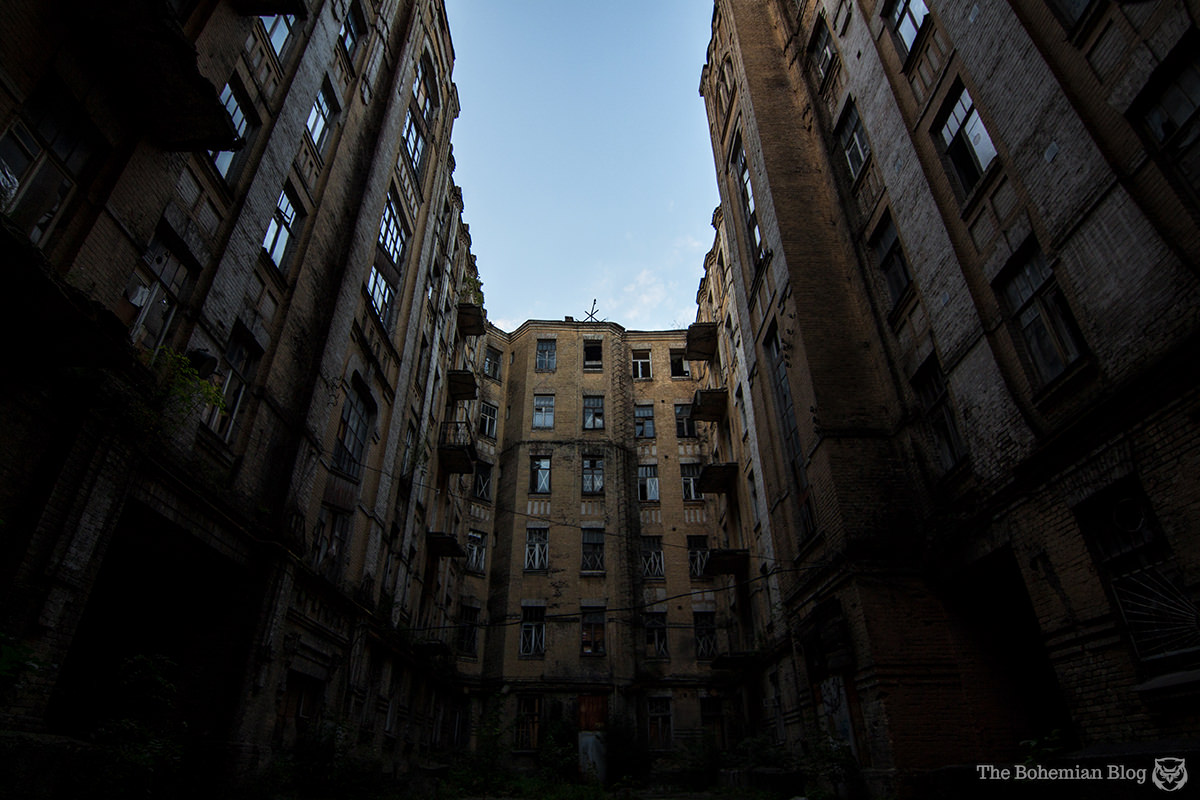
Maxim led us in through the garden. We climbed the wall from a regular, busy street, hopping the iron fence at the top to land in an overgrown space of brambles and dense vegetation. So far so good. While people here seem indifferent to urban explorers sneaking into drains, their attitudes to domestic trespass are altogether – and understandably – different. Here, Maxim told us, he had once run into the last resident of the ghost towers, a woman of questionable sanity who lived alone inside the derelict apartments; and she had not welcomed visitors to her hidden world.
The towers rose above us past the forest of a garden, a black cliff face against the blue-grey twilight. We crept closer and they filled the sky, until we passed beneath a brickwork arch and into the heart of this urban tumour. Walls of empty homes rose up on all four sides, an intimidating cage of post-apocalyptic textures. Broken glass and crumbling lintels, the desolate towers framed a rectangle of evening sky.
We were keen on getting inside the buildings – up to the rooftops, even, as Maxim said he had once managed – but for all their decay, the apartments were surprisingly difficult to enter. Rudimentary barricades had been built across every opening within reach. Corrugated sheet metal, bars and wooden pallets had been nailed, woven and welded together, a low-tech yet frustratingly effective system of defence that encased the first two floors of the building. Above that, windows gaped open to the sky, just out of reach.

I took the steps down to a basement-level entrance, and peered between wooden slats onto a grimy den of blankets, bottles and dust. I could have been inside in five minutes, had I been prepared to smash my way through – but I’ve never yet broken an entry, and I didn’t plan to start here.
Meanwhile, Maxim was at the opposite corner of the courtyard tiptoeing across a narrow balcony as he reached for an upper floor window. He made it to the windowsill, crossing a sheer drop down to the basement fire escape, and was preparing for a cat-like entry to the building through the narrow hole where a single pane of glass had fallen loose… when suddenly, we heard a shout.
Somewhere higher up, an elderly woman in a headscarf stepped out onto the balcony. She commandeered the courtyard like a tyrant at a podium, her voice bouncing about the walled-in space to amplify and distort. Most of it, I couldn’t make sense of – but I heard the word ‘politsiya’ at least, and the three of us decided to depart.
That night, Xiao and I took a trip to the suburbs… to explore the concrete mound known as ‘Stalin’s Subway,’ or ‘Objekt 1.’
This broken thing was designed as the entrance to a much larger structure; an attempted feat of urban engineering that sought to join either bank of the Dnieper with a subaquatic highway. The idea came down from Stalin himself, allegedly (and hence the name). Should Kyiv ever come under assault, if its bridges were destroyed, such tunnels would serve to stitch the city back together; allowing for fast, discreet deployment of military troops and ordnance.

The project began in 1938 under a team of 2,500 workers; by 1940, some 20,000 people had been employed. It wasn’t easy work. The tunnels were dug using non-mechanised boring machines, a process that subjected workers to highly pressurised atmospheres; decompression sickness was a common side effect. In February 1941, a pressurised tunnel burst open and flooded with water. That summer the project was halted and later, in 1949, the idea was officially scrapped altogether.
Arriving in darkness, along a path marked by flower-patterned tetrapods, the tunnel entrance loomed at us out of the night. That was all it was, though – an entrance, wide enough to drive a train through, followed by 35m of concrete tube and another gaping entrance at the other end. It looked misplaced on its hill above the park, naked, incomplete, like architectural leftovers.

We clambered in; over the broken bricks of a chest-high wall that might once, in its completed form, have blocked all entrance to the structure. Such barriers had been destroyed however, leaving the tunnel open to the night at either end… and painted throughout with splashes of graffiti that revealed many years’ worth of inquisitive exploration.
Over a second, higher wall we climbed, before dropping down into the space at the tunnel’s heart. Litter lay strewn about: broken pipes, plastic bags and empty bottles. Brick walls folded into the concrete arch of the tunnel, while above us, at the structure’s centre, a circular opening revealed a pool of stars. I backed into a corner to snap a photo and almost stepped into a pile of human excrement.
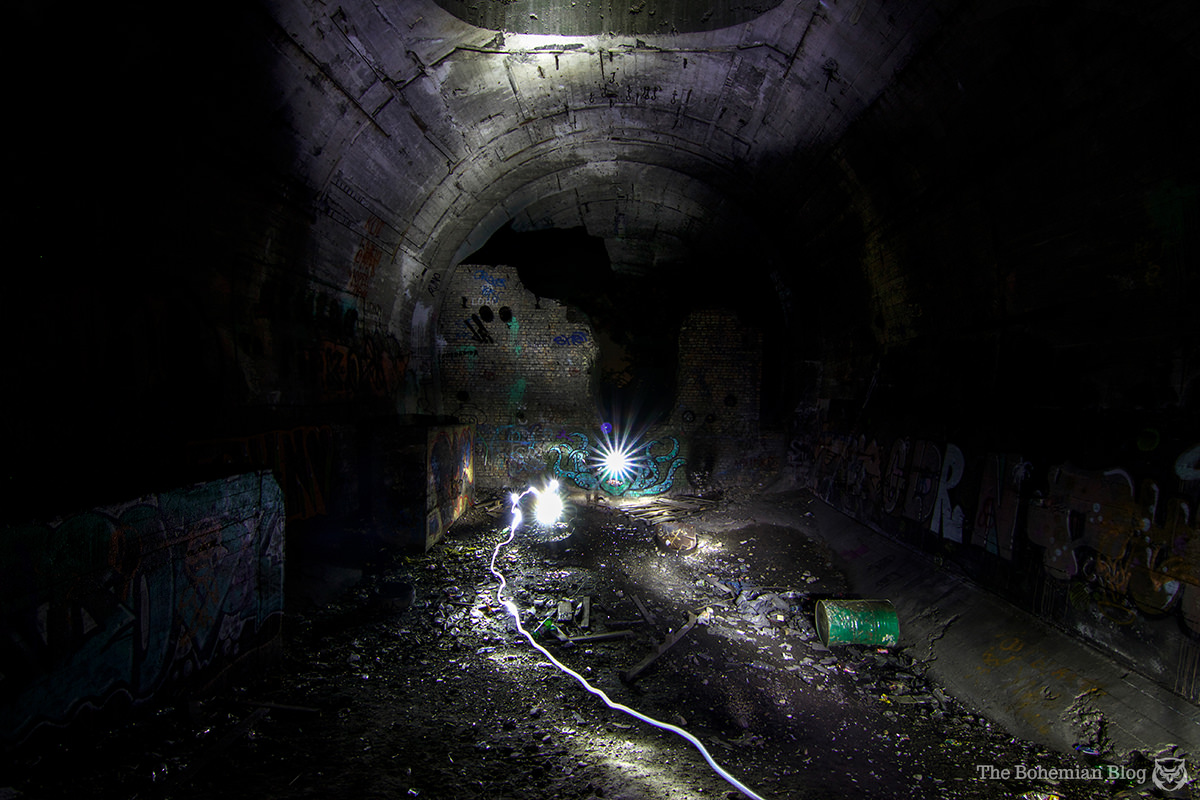
We didn’t stay for long – there wasn’t much to see, beyond the imposing outer edifice and a single gloomy space within. Objekt 1 exists today as an island, cut off from the sealed, lost and collapsed tunnels that it once promised access to. Stalin’s Subway was a husk, the shell of a grand engineering scheme now doomed to its afterlife as a public toilet… and as such, I mused, it seemed a fitting symbol for local feelings towards the great dictator himself.
Askold – son of Hvitserk, and heir to the semi-legendary Norse king Ragnar Lodbrok – settled at Kyiv in the 9th century, and from here ruled as prince over a newly founded Eastern Slavic state. A local legend tells that he was buried on Uhorska Hill, and in the 1930s the Soviets marked the location with a park known as ‘Askold’s Grave.’
Deep beneath Askold’s Grave, meanwhile, the hillside was hollowed out into a labyrinth of drains and overflow systems. The Soviet-era Askoldova Drain consists of a warren of concrete tubes that intersect with older systems, crossing paths with wells, tunnels, and deeper into the earth, with mine shafts that date back more than a hundred years.

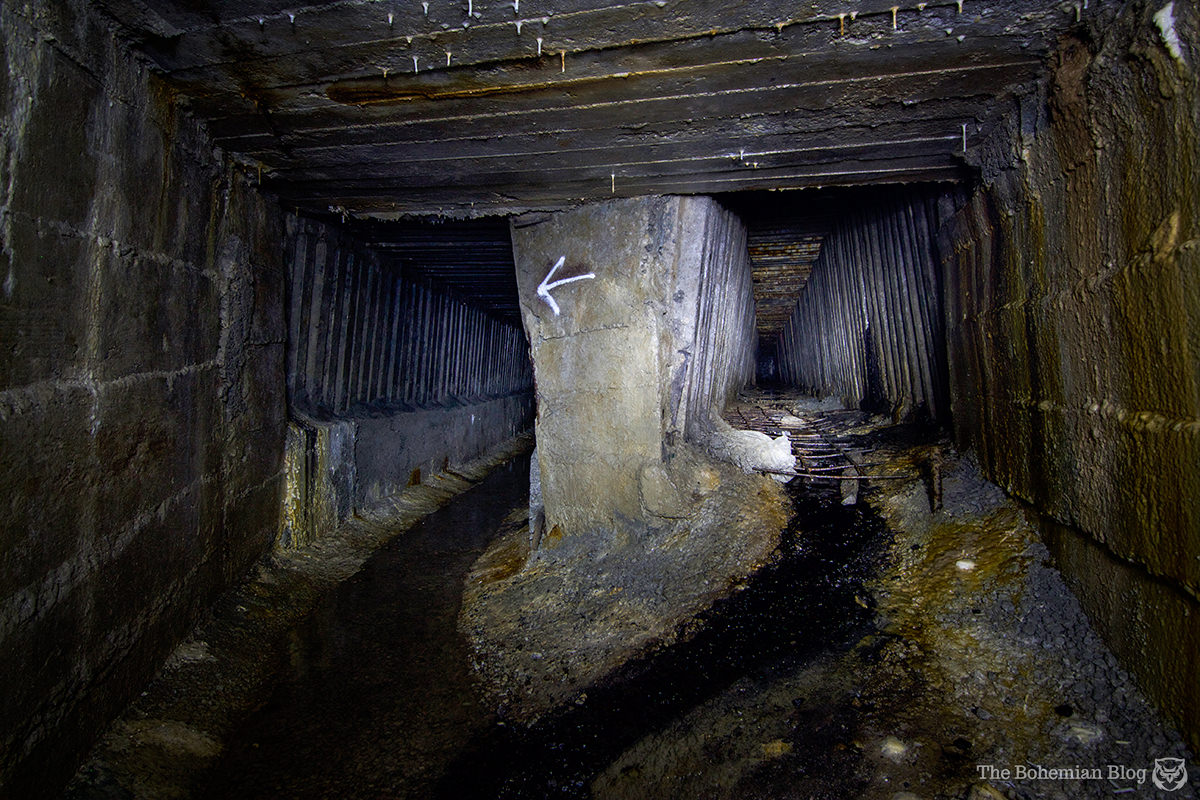
I visited the Askoldova Drain once before (I wrote about it here), but back then I’d struggled and (largely) failed to photograph these subterranean spaces. The passages are warm, clouded with mists that rise off the moving waters; moisture fills the air and in some of the deeper shafts, the spillover from higher levels falls down like torrential rain. From the very first moment we entered the drain, we stepped down into knee-deep water at the foot of the ladder – and before long, all three of us were soaked from head to foot.
The Askoldova drain system measures a total length of 5km, and it features some ingenious structural techniques. There are sections of the drain that date back as early as the late 19th century while many of the longer, Soviet-era passages are constructed from concrete ribs that look rather like the chocolate fingers of a Kit Kat – designed so that tiny gaps between the panels allow moisture to seep out of the subsoil and into dedicated drainage channels.
They didn’t make for particularly easy movement, however.


We were forced to duck as we progressed through the network, and soon I was aching from carrying a heavy bag on a bent back. After the first 20 minutes I found that bending at the knees, walking with a comical, elongated stoop was rather less painful… though even then, a few times I knocked my head on low-hanging pipes that protruded from the ribbed ceiling above.
We climbed up ladders, through gushing waterfalls; navigated a series of crossroads and intersections in the winding passages; and more than once, I wondered what this maze would feel like if we didn’t have an experienced guide to follow. I have never been claustrophobic, but still I got to thinking just how far I was from any space large enough simply to stand up in – and the deeper we progressed, the more unsettling that thought became.
It was all worthwhile though, by the time we reached our destination. Roughly 2km into the Askoldova Drain our passageway spilled out into a vast, open space: a shaft around the size of a metro tunnel stood on its end, where light – and water – rained down from a distant drain cover more than 30m overhead.



Three, maybe four hours later, we emerged; climbing out of a manhole in the park, all three of us aching from the work of trudging hunch-backed through the drains: wet, half-dead, and feeling more alive than ever.
Not far from Askold’s Grave, the trees echo with sounds of laughter and music. Kids drink beer around wooden benches; young romantics court at the riverside; while climbers sling their ropes around weathered stone, testing their skill against the sheer, red-brick walls of century-old military fortifications. By day, Maxim had pointed out the Green Theatre as we passed… then later, when darkness fell, Xiao and I returned.
We walked past the red brick building of the old commander’s office, and down to the retaining walls of the former fortress. Built in the 1850s, these walls had supported a military stronghold that overlooked the Nicholas Chain Bridge. That bridge itself was destroyed by Polish troops in 1920, during an engagement of the Polish-Soviet War; but the fortress walls remained, huge brick structures built into the hill and containing covered galleries, battlements, staircases and loopholes.
It would be another 30 years before they found new use.


Kyiv was hit hard by WWII, and the central Khreshchatyk Street, with its bars and cafes and entertainment venues, was largely reduced to ruins. Rebuilding the city took time and the post-war citizens of Kyiv craved distraction – so in 1949 the architect Alexander Vlasov proposed a new entertainments centre, a riverside theatre near Askold’s Grave. Rides and carousels appeared, along with the main attraction: an outdoor cinema and amphitheatre with space for 4,000 spectators.
The Green Theatre, as it was known, thrived for a decade. By the 1960s however, crowds were gradually being drawn away by the larger, covered concert hall of the newly-built October Palace. The Green Theatre underwent renovation work in the 1980s – the upper retaining walls were reinforced, while 900 new balcony seats were added – but by then the venue was already in decline. A fire in the 1990s finished it off, and the theatre has been a ruin ever since.
It is a peculiar place to visit after dark: the bare concrete steps of the amphitheatre rising up into a series of VIP tables designed with contours straight out of a 1970s casino; and above that, hanging like curtains against the night, the towering red bricks of the former fortress. But even fire and dereliction couldn’t kill off a location this good. Locals sat in groups about the Green Theatre as we arrived, smoking, drinking and laughing on the steps. The graffiti, the empty bottles and the litter, all of it seemed fresh – this place looked decidedly lived in rather than lost.


Over the years, the Green Theatre has inspired more than its share of urban myths. Some say its history goes back much further than official reports, built on a previous fortress founded in 1161. There are rumours that its basements extend for nine levels beneath the ground… or to passages that connect to the nearby Arsenal factory. There are stories too about sinister cults practicing rituals in those dungeons, or of a hooded phantom that stalks the theatre at night.
I saw none of that, not even inside the slippery, mud-filled tunnels of the old retaining walls; yet local mythology can’t help but add flavour to what these ruins have become: a scenic, bohemian hangout perched somewhere on the boundary between antiquity and green eternity.
The Glubochitsa River rises in Lukyanivka and winds through the downtown Podil district of Kyiv before emptying its waters into the harbour. These days, however, it crosses the capital unseen – folded deep into the sub-street fabric of the city where it pours through a system of underground caverns and tunnels.
We entered the secret river in plain sight. Maxim popped the lid to a drain, as we stood about the footpath. Just beyond the pavement traffic sailed by, disinterested. We shifted the man-hole lid to one side and then sat on the edge of darkness, lowering ourselves one after the next into the river.


I landed first in the underground, stepping off the ladder to test the silty riverbank with my boot. Beside me, in the darkness, I could hear the rush of water as it polished the stone-lined basin of the underground river. I flicked on my headlamp. Compared to the Askoldova Drain, the passage that contains the Glubochitsa River was clearly the product of another era. It opened out ahead in a pale brick tube – as noble, as satisfying to behold, as any of London’s Victorian-era train arches.
For perhaps an hour we explored that segment of the tunnel: hopping from one bank to the other, lighting it up for photographs. Later I heard a clatter, and then by the entrance ladder a light flashed down from the street. After that boots appeared, following us down, one rung at a time.

It was a couple who appeared from the opening, stepping down into the cavern with practised ease before offering us an amiable greeting. They had been passing by, they explained (by way of Maxim’s translation), they saw the cover open and decided to stop in – and then they were gone, their torchlights shrinking as they wandered off down the river, while we made our own way back to the city’s surface.
“We’re going to cross the river now,” Maxim said, and smiled. “But we’re going underneath.”
He led us toward the water, through a residential area lit by sporadic streetlights. We followed disused rail tracks as we veered away from habitation, into a scattering of low-level industrial units that lay tucked behind high walls at the riverfront. Our target was unexceptional: a squat, plain-looking structure which Maxim immediately set about opening with his skeleton keys. Before we entered, he invited us to take in the view. I scrambled up to peer over the wall – the river wound past as a wide, black ribbon between this bank and the distant lights of the next. That was where we were headed.
The building was devilishly hot inside. It connected to heating pipes and cable runs, an old tunnel pumping urban utilities beneath the Dnieper River. Within a minute I was sweating, and I tied my coat around my waist as I began the climb down to lower levels.

Maxim flicked on a light switch, and lit up an industrial scramble of pipes and machinery. Steps descended below ground level, and from the basement we followed a path of ladders and gantries: squeezing around wheels and dials, past giant tubes clad in fibreglass. I could feel the warmth coming off the metal – see the heat haze rising in my torchlight.
Past the engine rooms, a corridor broke off from the lowest floor… descending at a 45-degree angle into darkness. At the bottom it levelled out, into a long walkway flanked in heavy pipes and cables. It ran all the way beneath the River Dnieper.
We walked to the far bank through that passage, the metal gantries clanging and ringing beneath our booted feet. At the far end, it rose again: into another surface block, not dissimilar to the building through which we’d entered. We took some photos, but I couldn’t stay for long. That sub-aquatic passage had felt cooler than the machine room, but after a while even that became unbearable. The air was thin and dusty, while the heat was incessant – I sweated, itched, and when I began to feel light-headed I knew it was time to get out.
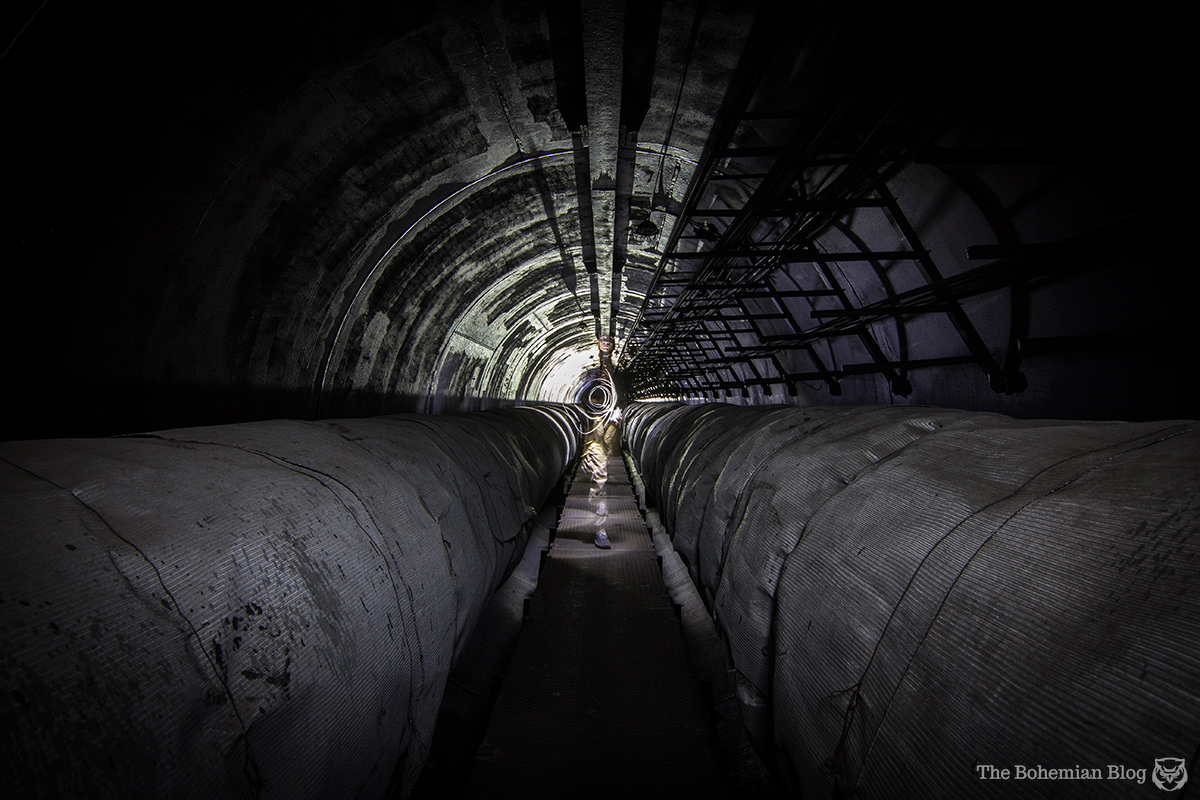
Stood on the riverbank, the cold air brought me back to life. It was almost midnight – 48 hours since the cemetery, the crematorium – and I realised it had been a solid two days of darkness. Whether underground, or under the stars, I had barely seen the sun in all this time.
We parted ways with Maxim at the metro. He was headed home, while Xiao and I had to go and prepare for a two-day trip to the Chernobyl Exclusion Zone; I would end up taking plenty more photographs before this Ukrainian trip was over, and it wasn’t until a week later that I finally had the chance to slow down, relax, put my camera away and begin to catch up on lost sleep.
Sudden exhaustion hit me as I boarded my flight out of Kyiv. I collapsed into the seat, picked up an inflight magazine and started flicking idly through the glossy pages. It fell open at an article about Ukraine, a review of the capital’s trendiest hidden bars, its lesser-known record stores, coffee shops, and various other up-and-coming hipster destinations. The title of the piece read ‘Kyiv’s Hidden Secrets’ and I thought to myself, You don’t know the half of it.
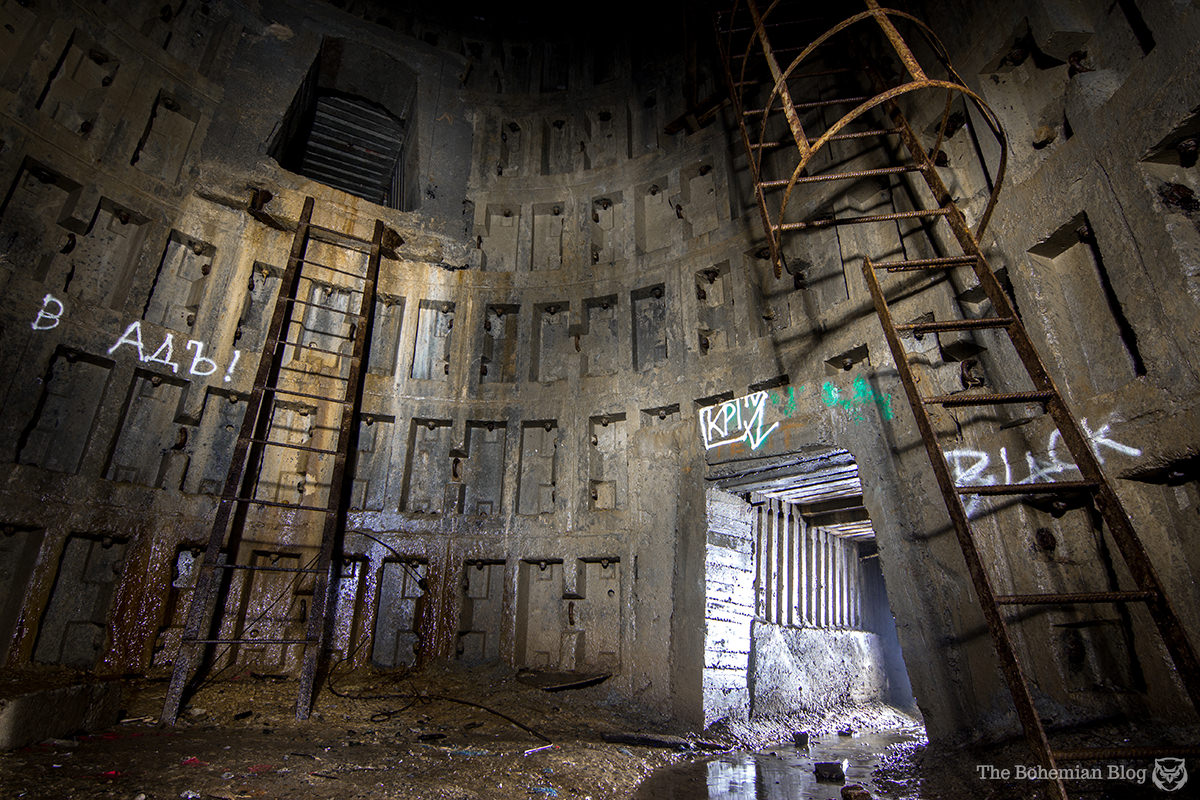




Comments are closed.

An illustrated guide to urban exploration in the Russian capital.

Poltergeists, ritual murder & a live-in succubus – the 1000-year-old pub with a ghostly reputation

A month-long monument hunt, and what I learned along the way.
do you have any photos of the cellars under the October palace where thousands of prisoners were shot dead by NKVD in the 1930s and ealry 1940s?
Had some issues with using PayPal. I just resent with my intended donation.
Thank you, Steven!
This post is amazing. You’re making me want to travel to places I never once dreamed of visiting. Keep going at these posts, man 🙂
Thanks, Calum. That’s exactly the desired effect. 🙂